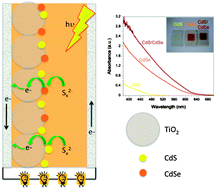Photo-induced charge transfer dynamics in efficient TiO2/CdS/CdSe sensitized solar cells†
Abstract
Nanocrystalline

* Corresponding authors
a
Institute of Chemical Research of Catalonia, Avda. Països Catalans, 16, Tarragona, Spain
E-mail:
epalomares@iciq.es
Fax: +34 977 920 224
Tel: +34 977 920 241
b ICREA, Passeig Lluís Companys 28, Barcelona, Spain
Nanocrystalline

 Please wait while we load your content...
Something went wrong. Try again?
Please wait while we load your content...
Something went wrong. Try again?
T. Zewdu, J. N. Clifford, J. P. Hernández and E. Palomares, Energy Environ. Sci., 2011, 4, 4633 DOI: 10.1039/C1EE02088A
To request permission to reproduce material from this article, please go to the Copyright Clearance Center request page.
If you are an author contributing to an RSC publication, you do not need to request permission provided correct acknowledgement is given.
If you are the author of this article, you do not need to request permission to reproduce figures and diagrams provided correct acknowledgement is given. If you want to reproduce the whole article in a third-party publication (excluding your thesis/dissertation for which permission is not required) please go to the Copyright Clearance Center request page.
Read more about how to correctly acknowledge RSC content.
 Fetching data from CrossRef.
Fetching data from CrossRef.
This may take some time to load.
Loading related content
